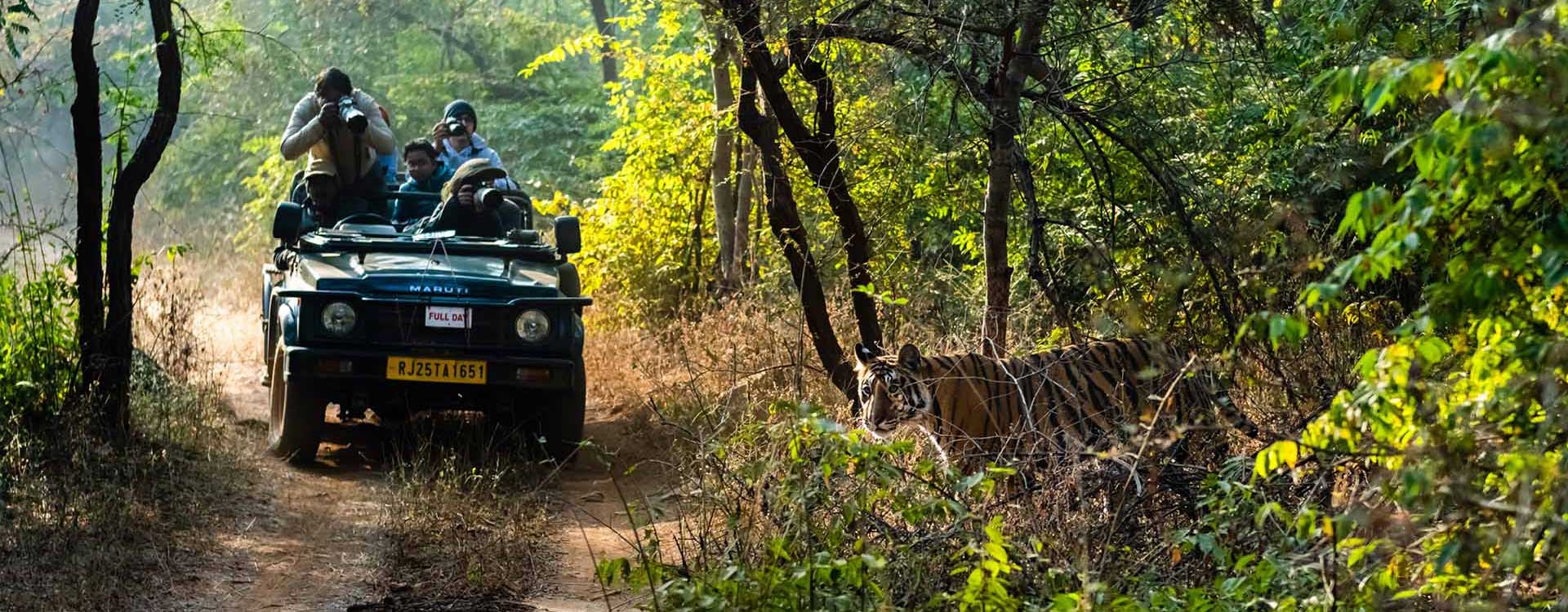
Ranthambore
Ranthambore National Park is a vast wildlife reserve near the town of Sawai Madhopur in Rajasthan, northern India. It is a former royal hunting ground and home to tigers, leopards and marsh crocodiles. Its landmarks include the imposing 10th-century Ranthambore Fort, on a hilltop, and the Ganesh Mandir temple. Also in the park, Padam Talao Lake is known for its abundance of water lilies.
The Ranthambore National Park is where you should land up if you want to spot the king of the jungle. The park covers 1334 sq.km. of thick jungle, winding dirt roads, and lakes, making a safari here a once in a lifetime experience.
Ranthambore National Park is perfect for animal lovers. Besides glimpses of the tiger in its natural habitat, the park is home to nilgai, wolf, sambhar, bear, hyena, jackal, caracal, and leopard. The park is also a birdwatcher’s paradise with the nightjar, greylag goose, great crested grebe, and a number of migratory birds that inhabit the tall trees and bushes. The best time to visit the park is between October and April.
Ranthambore National Park’s unparalleled topography is a welcome change. The wild jungle is spread out over deep valleys and bluffs, spotted with rivers and lakes, making it a nature lover’s dream. While the animals are the main draw, there are a number of other attractions within the park that should be explored.
The Ranthambore National Park (RNP) is in the languid, railway town of Sawai Modhpur. The wildlife park covers over 1300 sq. km. and the forested lands will remind you of The Jungle Book, with its thick tree cover, steep crags and watering holes where animals come to quench their thirst.
Ranthambore National Park is home to 60 tigers and they’re easily the biggest reason why wildlife lovers and nature enthusiasts land up here. The Project Tiger initiative has allowed the park to provide a natural home for these endangered animals, and it is immensely heart-warming to view these creatures strolling about the Ranthambore jungle. The early morning and evening safaris will take you through wild jungle and it is certainly a bucket list worthy experience. You will be surprised to know that there are over 300 hamlets in and around Ranthambore National Park. The villagers here manage to live without encroaching into animal territory.
Ranthambore National Park also contains an ancient fort, royal pavilions and frequently visited temples. The park is shut from July to September, and the best time to turn up is during the winter months. If you’re deciding on how to reach Ranthambore National Park, let us help you plan your itinerary so you can get there and have a good time amidst nature.
The closest airport to Ranthambore National Park is Jaipur International Airport. International visitors can fly into Jaipur and then hire a car that will take around 3 hours to reach the town of Sawai Modhpur where the park is located. If you’re short on time and don’t mind spending on flight tickets, this is the quickest transportation option at your disposal.
Travellers can even opt to fly to Kota Airport (only domestic flights), where the journey to Ranthambore National Park is just 135 kms away.
The simplest way to get to Ranthambore National Park is by train. You know you’re about to witness a wildlife spectacle as soon as you exit the train at the Sawai Modhpur Junction. The walls of the railway station are done up with pictorial representations of animals and nature inspired by Ranthambore National Park. That aside, the Sawai Modhpur Junction is connected to all major cities in Rajasthan and India.
There are trains running from Jaipur and Delhi to Sawai Modhpur on a nearly daily basis. The Ranthambore National Park is an 18km car or bus ride away from the railway station.
If you’re travelling to Ranthambore between October and February, make sure you reserve your train tickets well in advance. Peak tourist season will find a number of travellers visiting the park to witness the animals. Always book your tickets via irctc.co.in
The bus or car journey to Ranthambore National Park guarantees beautiful views of the state’s natural landscape. There are a number of government-run and private buses that operate from major Rajasthani cities. If you’re up for a road trip, you can even hire a care to get to Sawai Modhpur and then to the park. The most common route is from Jaipur that is just 181kms away. There are buses that run from Jodhpur, Bharatpur, Kota and Delhi, as well.
Make sure you pick the right mode of transportation while planning on how to reach Ranthambore National Park. A train journey is easily your best option.
Ranthambore National Park remains open from the months of October to June, with the winter months (October - December) being the best time to visit this place. October to April are the best months to visit Ranthambore to spot tigers. Summers are quite hot, however, chances of spotting tigers increase in the summers. The park remains closed during monsoons.
Perhaps the perfect time to take a trip to the Ranthambore National Park, the months between October and March experience pleasant weather, complete with clusters of flowers that adorn the landscape beautifully. If you are planning your trip sometime between late December and early January, however, be prepared with warm woollen clothes to keep you cosy during the cold weather. The temperatures range between 10 degree Celsius and 27 degree Celsius. Apart from the tiger safaris, make sure to head out to the Ranthambore Fort, Malik Talao, and Kachida Valley, all of which lay within the reserve itself, the latter being home to numerous migratory birds as well as panthers. Ganesh Trinetra Temple, Lakarda and Anantpura, Wild Dragon Adventure Park, Dastkar Ranthambore, and Rajiv Gandhi Regional Museum of Natural History are some of the other places that you should add to your itinerary.
The Ranthambore National Park remains closed during the monsoon months of July to September. Hence, these months are a no-no to visit the area during the rainy season.
Since Ranthambore is nestled in Rajasthan, the summer months, starting from April to June, receive unbearable dry heat as the direct rays of the sun hit the area. However, if you think you shall remain unperturbed by the extreme temperatures, which may even go up to 36 degree Celsius, then it is the best time to visit this reserve since it is during these months that you are most likely to luck out and spot the majestic tigers, along with several other animals. Make sure to keep a scarf with you, apply huge dollops of sunscreen, and stay hydrated all the time. To avoid the direct rays of the sun, try to wear full-sleeved cotton clothes. You may also sit and relax by the enrapturing Surwal Lake, visit the grand Jogi Mahal nestled near the Padam Lake, or take a trip to Raj Bagh Talao, with the Raj Bagh Ruins in its backdrop.
Among the best places to visit in Ranthambore, Ranthambore fort is an unavoidable spot which lies within the national park vicinity near the Sawai Madhopur. It is a well -known space since the rulers of ancient period used to reach here for hunting. It played a definite role in making the tourism part of Rajasthan to the next level.The fort exhibits the exemplary glory and valor of Hammir Dev of the Chauhan dynasty. Also, it is considered as a precious spot since it is one of the World Heritage List. The fort is located amidst a pristine location abundantly nurtured by thick green forests and salubrious climate. In addition, nearby the fort, you can witness different types of valleys, lakes, picnic spots, wild life species etc. Along with the fort, there is a history travelled; the history of wars and captures, different conquerors and the changes happened to the fort in time to time.
Padam Palao is the largest lake inside Ranthambore National Park. At the edge of this lake, you can see the very famous Jogi Mahal. The lily flowers which are the reason for the lake to get its name as Padam Talao will be seen in abundance during the season. The surrounding of the lake is beautified with thick green forests.Along with it, the relishing sights of umpteen numbers of birds coming to the lake will attract everyone’s eyes and heart. In the early morning and evening, you can also see the wild animals coming to drink water from the lake. The National Park’s whole beauty is enhanced by the presence of this picturesque lake filled with lilies at times. The rare sights of Chinkara are possible at the very edge if this particular lake.
One of the three lakes in Ranthambore National park, Malik Talo, comparatively the smaller is considered to be a must visit among the places to visit in Ranthambore. Nestled amidst the huge green forest, it acts as a haven for thousands of migratory birds as well as Marsh crocodiles.Whenever you visit Ranthambore National Park, never forget to visit this particular lake which opens to the visitors at two different timings either in the morning or in the evening. You might get to see some variety types of birds as well that come to catch their food from the lake. The view of the surroundings will nourish your eyes undoubtedly and it will be obviously a picturesque nature everywhere. Also if luck favors, you will spot the wild animals coming to drink water from the lake at times.
Raj Bagh Talao is comparatively the most beautiful among the three lakes within Ranthambore National Park. The ruins at the extreme edges of the lake add more beauty to it. Since it is located amidst the lush green forests reserve, the wildlife animals are the frequent visitors to the lakes for drinking water.The sambhar deer is a regular visitor who eats the grass present on the floor of the lake. Rare types of birds, animals, and species come around the vicinity of the lake in the morning and evening when the weather seems to be cooler. It is a tiger spotting area as well along with other rare animals in the park come since the area has a wide range of forest area and water resources.
The Rajiv Gandhi National Museum or The Regional Museum of Natural History, Sawai Madhopur is India's fourth regional museum of natural history and it is termed as one of the best places to visit in Ranthambore. The museum has the exhibits of rare plants, animals and, geology of the Western part of India. The main aim of this museum is to create awareness among the public about the importance of preserving the flora and fauna which are very rare in the surrounding.It helps to understand the diversity of earth as well. There are three floors in the museum but the visitors have access only to the ground floor where 'Biodiversity of Rajasthan or Forests and Wildlife of Rajasthan' are mainly exhibited. The facsimile of animals such as chinkara (gazelle), leopard, lion, and tiger are the main attractions along with the collection of village dioramas of the Bishnoi community and Rajasthan rural area.Location: Ramsinghpura, Sawai Madhopur, Ranthambore, Rajasthan.





